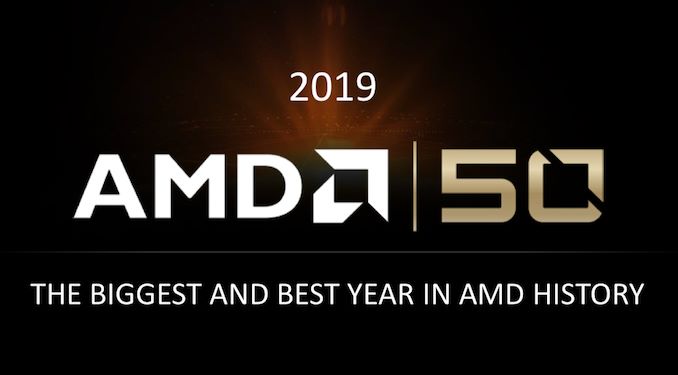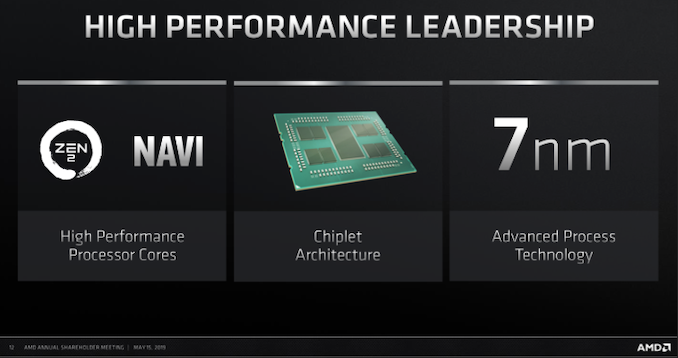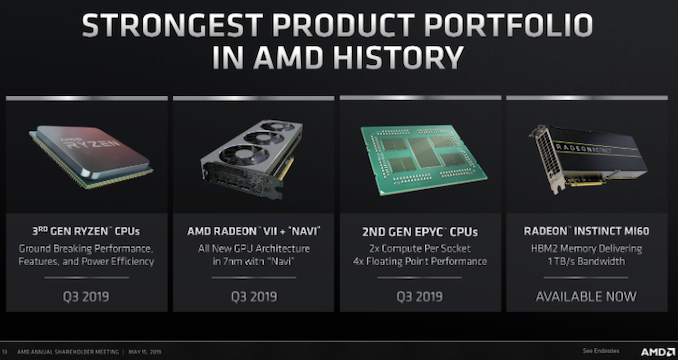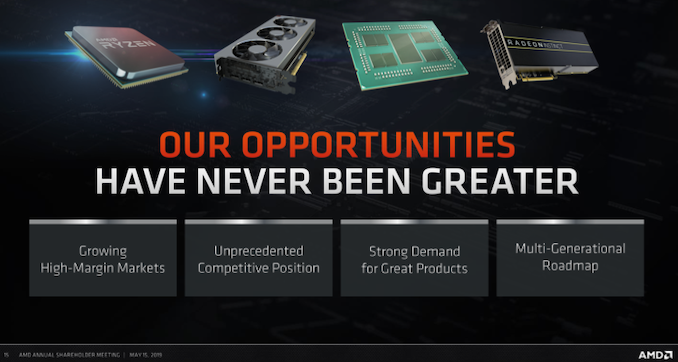AMD Reiterates 7nm Roadmap: Navi, Matisse, & Rome to Launch in Q3
by Anton Shilov on May 17, 2019 8:00 AM EST
AMD this week held its Annual Shareholder Meeting where it reiterated its current technology roadmap and once again confirmed that that its major products set to be released this year based on 7nm will be formally introduced in Q3. Previously the company implied on launch timeframes of its Navi GPU (at least one of them), Matisse CPUs, and Rome server CPUs, but never made a firm promise about the third quarter - this announcement is a commitment to delivering these products in Q3.
The High Level
On a high level, AMD believes that there are four technology pillars that will define its product roadmap in 2019 and forward. These pillars are: the Zen 2 CPU microarchitecture, its Navi GPU architecture, chiplet-based design architecture that enables it to mix and match features and technologies to build a right processor for a given platform, and IP for TSMC’s 7 nm manufacturing technology.
Since R&D processes take years, it was crucial for AMD to make the correct bets when its comes to microarchitecture and fabrication process. That said, this year’s product launches represent a culmination of multi-year efforts by the whole company, but considering that numerous architectural things may be re-used for years, it is important that they have been developed and implemented.
The Products
AMD’s 3rd Generation Ryzen processor, known as Matisse, promises a significant performance increase in general-purpose tasks from where AMD is today. It also adds several new features, such as PCIe 4.0 interface support. Launching this product “shortly in Q3” means that the company wants to make it available already during the important back-to-school season and well ahead of critically important holiday sales season.
Another vital product series for AMD is its next-gen lineup of GPUs based on its Navi architecture. At least one of these graphics processors will be launched in the third quarter. What is noteworthy is that Navi GPUs will coexist with AMD’s Radeon VII graphics cards, which indicates that the latter will continue to serve the enthusiast segment of the market. Furthermore, AMD’s 7nm Vega GPU in the form of the Radeon Instinct MI60 will continue to be offered for high-performance computing workloads.
Also due in Q3 are AMD’s 2nd Gen EPYC processors, known as Rome. These server CPUs are set to feature up to 64 cores powered by the company’s Zen 2 microarchitecture. It is worth keeping in mind that it takes server users some time to adopt new CPUs, and the launch of AMD’s 2nd Gen EPYC in Q3 does not necessarily mean that these processors will be used by a massive amount of designs straight away. Nonetheless, it is still important to release them rather sooner than later in a bid to ramp them up as soon as possible.
One product family worth mentioning is Threadripper. AMD's high-end desktop platform, currently available at 8-32 cores, is expected to be encroached on by the Ryzen 3000 series. AMD briefly held in its roadmaps that Threadripper based on Rome would be coming in 2019, however in its most recent disclosures, that commitment has no longer appeared and AMD has not commented on the matter. It could be that someone made a mistake putting it on the singular slide deck in which it appeared, or there's a level of inconsistency between AMD's presentation teams based on what they are presenting to whom. Hopefully AMD will clarify the matter in due course, and with Computex coming in two weeks, it would be a perfect time to do so.
Related Reading:
- AMD To Host “Next Horizon Gaming” Event & Product Unveil at E3 2019: June 10th, 3pm PT
- AMD: 7nm ‘Navi’ GPU & 'Rome' CPU to Launch in Q3
- AMD's 7nm CPUs & GPUs To Be Fabbed by TSMC, on Track for 2018 - 2019
- AMD Tech Day at CES: 2018 Roadmap Revealed, with Ryzen APUs, Zen+ on 12nm, Vega on 7nm
- AMD Unveils GPU Architecture Roadmap: After Polaris Comes Vega
Source: AMD













55 Comments
View All Comments
rahvin - Sunday, May 19, 2019 - link
I wonder if he listened to the call because I distinctly remember them saying they'd have threadripper in 2019 but gave the impression it would be after Epyc ramps.sorten - Friday, May 17, 2019 - link
These products are going to be "formally introduced" in 10 days, in Q2, and sold starting early Q3.HardwareDufus - Friday, May 17, 2019 - link
hmmm, I might be building my first desktop since 2012 soon (my I7-3770k has served me well and remained perfectly relevant...).i imagine it will be the last desktop I will build in my IT career (I hope to hang-up coding in 2025... not retire... just do something else w/ less stress).
I haven't bought a discreet video card in forever (Athlon days), as I've been on the core architecture and just used integrated graphics for a long time. Maybe, I'll treat myself to a monster video card, monster CPU, high capacity m2 drives, tons of DDR4 memory... this third quarter.
My I7-3770k will make a nice little server for development work.
peevee - Friday, May 17, 2019 - link
At this point for platform longevity, I'd wait for DDR5 and maybe PCIe5-based platform. DDR4 is already very old and DDR5 chips @6400MT/s are being mass-produced for months, and PCIe4 looks to be a short-lived standard.mode_13h - Saturday, May 18, 2019 - link
How does PCIe 5.0's power consumption compare with 4.0? Early reports are that 4.0 runs hot. If 5.0 is even hotter, that might be a reason for 4.0 to stick around on the desktop, for a while.Intel won't even have 4.0 on desktop chips for a couple more generations.
peevee - Monday, May 20, 2019 - link
"Intel won't even have 4.0 on desktop chips for a couple more generations."What is your source for that? I am pretty sure as soon as they separate cores from I/O again, they will implement 4 or even directly 5. Maybe even in the next few months.
Qasar - Monday, May 20, 2019 - link
peevee...where is your source for that ?? or is this just your own speculation ?
mode_13h - Tuesday, May 21, 2019 - link
I probably saw it in the latest batch of Intel roadmap leaks.0ldman79 - Saturday, May 18, 2019 - link
I've got a Xeon Ivy Bridge clocked at 3770K speeds.Just to make sure you know, it is nearly identical in performance to a Ryzen 1500x. On most games there's little difference even upgrading to an 8 core.
If you do other things as well, like I do, that 8 core is looking pretty good, but I try to hold out until I get 3 to 4x my performance before I upgrade. 12 and 16 cores are my target at the moment.
webdoctors - Friday, May 17, 2019 - link
"Strongest portfolio in AMD's history"?Isn't every company's product portfolio the strongest in its companies' history? Wouldn't a better comparison be to industry or a 3rd party rather than itself? It'd be like saying I've never been older than I am today LOL.